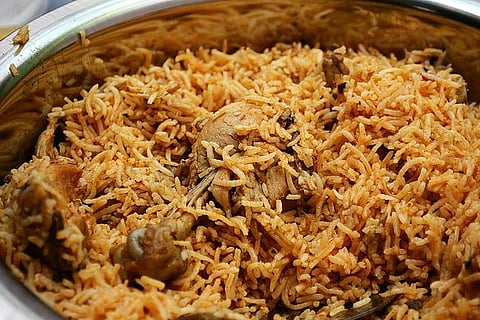

When you are on the Chennai- Bengaluru Highway, you might miss the only turn in Krishnagiri that you need to take in the entire stretch but you cannot miss the giant signboards that tell you that you are X km from authentic Ambur Briyani or Dindugal Thalappakattu Briyani. Even if you do miss the turn and land in the Dharmapuri-Krishnagiri Road, don’t worry; you can sniff your way back to the Biryani highway.
Ambur is a significant pin on the Biryani map of Tamil Nadu. In 1890, a descendent from Mughal and Nawabi kitchens decided to set shop in Ambur. Hasin Baig wanted the common man to have a taste of royal biryanis. Rahmaniya and Khursheed, the predecessors of Star Briyani were thus born.
The oldest Ambur biryani shop still functions in the Bazaar Road of this tiny town. It is not uncommon to find people who have biryani for breakfast, lunch and dinner in Ambur. Over the years, Star realised that they were strategically placed between Bengaluru and Chennai and moved to the highway to cater to the crowd that drives between the two cities.
Today, Star has evolved as a biryani chain and has outlets all over south India.
Image courtesy: Ambur biryani; Screenshot/YouTube
What is so special about Ambur biryani? The masala is handmade, says Rajesh, Manager of one of Ambur’s Star outlets.
Ginger, garlic and chilli are still pounded by hand and not bought pre-packaged. Using motorised grinders and mixers ruins masalas, he says. On Eid day, Rajesh manned the busy biryani place and says he sold over 250 kg of biryani well before dinner time!
Amidst the bustle of customers, Rajesh takes time to tell us that the specialty of their biryani lies in the rice. While other biryani varieties use the aromatic and slender long grain Basmati, Ambur biryani makes use of seeraga samba.
Seeraga samba is a short and round grain that used to be grown and sourced within Tamil Nadu. But now, to keep up with our biryani consumption, it’s sourced from West Bengal. Vaniyambadi, the next town on the biryani highway offers its own variety of biryani. For the undiscerning palate, the biryani from these two towns taste similar but patrons know the origin of their rice, meat and masala.
Dindugal Thalappakatti is a widespread biryani brand from Tamil Nadu. Contrary to the common belief that Muslims are the only ones to nail the perfect biryani, Nagasami Naidu and his wife started selling sumptuous biryani at Dindugal Anandha Vilas, way back in 1957.
His clientele called him Thalapakatti Naidu because he always wore a turban. And thus the Thalappakatti Biryani was born. This variety of biryani also uses the seeraga samba grain. They are finicky about the meat that goes into their briyanis. Only the meat from the best grass fed Kannivadi goat is used to make authentic Dindugal Thalapakatti biryani.
The success of this brand of biryani led to the mindless copying of the brand name by others. In 2013, Dindugal Thalapakatti won a trademark case with a Chennai based ‘Thalapakattu’ brand of briyanis.
Image courtesy: Dindugal biryani; Screenshot/Youtube
While biryanis outside Tamil Nadu use green chillies for spice, most Tamil biryani recipes swear by dried red chillies. Several Tamil Muslim homes serve semiya biryani where vermicelli is used instead of rice.
The vegetarians have their options, too. There’s vegetable biryani, paneer biryani, mushroom biryani and soya biryani cooked in these styles. Such is the south Indian’s love for rice and spice! It’s no wonder the common notion is that attendance in political rallies can be bought with a packet of biryani.
Saravanan Mohanakrishnan, a biryani patron from Bengaluru, prefers Anjappar’s biryani any day.
"I like Basmati biryani that is mixed well and when flavours have seeped into the rice and meat. I don’t like it when I have to dig into layers and see three different layers, cooked in isolation from one another. The masalas in Anjappar biryani have a distinct south indian – Chettinadu taste. Biryani should be fiery and spicy. Ambur and Thalappakatti briyanis are for spice intolerant palates," he says.
Vijay Muthu, a data analyst from Chennai believes that Ponnusamy’s Mutton Biryani is a cut above the rest while Ramya Sathish, a content writer who has spent time in Chennai and Bengaluru, says she’s impartial to biryani varieties. She likes Sindhi Briyani, Memoni Briyani or the Thalassery Biryani as much as she likes the simple and flavourful biryani sold from carts in and around Chennai.
An order of biryani generally means a side of onion raitha for those looking to mitigate spice levels while others opt for an eggplant gravy.